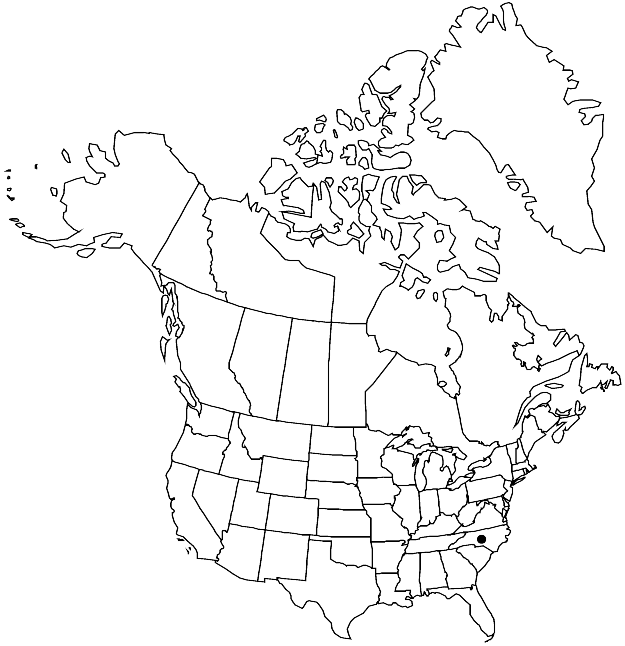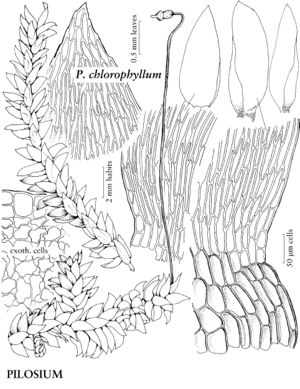Difference between revisions of "Pilosium chlorophyllum"
in H. G. A. Engler et al., Nat. Pflanzenfam. ed. 2, 11: 399. 1925.
FNA>Volume Importer |
FNA>Volume Importer |
||
| Line 33: | Line 33: | ||
|elevation=moderate elevations (600-800 m) | |elevation=moderate elevations (600-800 m) | ||
|distribution=N.C.;Mexico (Quintana Roo);West Indies;Central America;n South America. | |distribution=N.C.;Mexico (Quintana Roo);West Indies;Central America;n South America. | ||
| − | |discussion=<p>Pilosium chlorophyllum is rarely confused with other species in Stereophyllaceae. The species is distinctive because of its glossy, complanate-foliate plants, and dimorphic leaves, the dorsal ones symmetric and oblong-ovate, with neither a costa nor a distinctive alar region of differentiated cells, the lateral ones cultriform and oblong-lanceolate, with a short, weak costa scarcely reaching 1/3 leaf length, and a large area of enlarged, pigmented alar cells on one side of the costa. The cernuous, short-cylindric capsules have collenchymatous exothecial cells and the spores, 7–9 µm, are smaller than in other members of the family.</p> | + | |discussion=<p><i>Pilosium chlorophyllum</i> is rarely confused with other species in Stereophyllaceae. The species is distinctive because of its glossy, complanate-foliate plants, and dimorphic leaves, the dorsal ones symmetric and oblong-ovate, with neither a costa nor a distinctive alar region of differentiated cells, the lateral ones cultriform and oblong-lanceolate, with a short, weak costa scarcely reaching 1/3 leaf length, and a large area of enlarged, pigmented alar cells on one side of the costa. The cernuous, short-cylindric capsules have collenchymatous exothecial cells and the spores, 7–9 µm, are smaller than in other members of the family.</p> |
|tables= | |tables= | ||
|references= | |references= | ||
| Line 57: | Line 57: | ||
|publication year=1925 | |publication year=1925 | ||
|special status=Selected by author to be illustrated | |special status=Selected by author to be illustrated | ||
| − | |source xml=https://jpend@bitbucket.org/aafc-mbb/fna-data-curation.git/src/ | + | |source xml=https://jpend@bitbucket.org/aafc-mbb/fna-data-curation.git/src/8f726806613d60c220dc4493de13607dd3150896/coarse_grained_fna_xml/V28/V28_738.xml |
|genus=Pilosium | |genus=Pilosium | ||
|species=Pilosium chlorophyllum | |species=Pilosium chlorophyllum | ||
Revision as of 17:07, 18 September 2019
Stems 6 cm, 2–4 mm wide across leafy stem. Leaves dorsal 1.3–1.6 × 0.6–0.9 mm, alar cells few, weakly differentiated, 12–24 × 9–12 µm, walls not porose; lateral 1.5–2 × 0.6–1 mm, costa extending short distance beyond base, alar cells many, strongly differentiated, 24–89 × 14–28 µm, walls porose; medial laminal cells 89–146 × 7–12 µm. Perichaetia with leaves deeply erose. Seta 1.5–1.8 cm. Capsule 0.8–1.2 mm; operculum 0.4–0.6 mm.
Phenology: Capsules mature winter.
Habitat: Forested sheltered gorges, rotten logs, exposed tree roots
Elevation: moderate elevations (600-800 m)
Distribution

N.C., Mexico (Quintana Roo), West Indies, Central America, n South America.
Discussion
Pilosium chlorophyllum is rarely confused with other species in Stereophyllaceae. The species is distinctive because of its glossy, complanate-foliate plants, and dimorphic leaves, the dorsal ones symmetric and oblong-ovate, with neither a costa nor a distinctive alar region of differentiated cells, the lateral ones cultriform and oblong-lanceolate, with a short, weak costa scarcely reaching 1/3 leaf length, and a large area of enlarged, pigmented alar cells on one side of the costa. The cernuous, short-cylindric capsules have collenchymatous exothecial cells and the spores, 7–9 µm, are smaller than in other members of the family.
Selected References
None.
